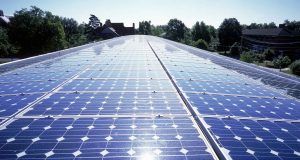India’s solar energy capacity has expanded by a record 5,525.98 MW in 2016-17, according to the latest figures provided by the ministry of new and renewable energy (MNRE).
 In comparison, India had added 3,010 MW of solar capacity in 2015-16, which shows that growth nearly doubled over the past year. Cumulative solar capacity currently stands at 12,288.83 MW, against 6,762.85 MW at the end of March 2016.
In comparison, India had added 3,010 MW of solar capacity in 2015-16, which shows that growth nearly doubled over the past year. Cumulative solar capacity currently stands at 12,288.83 MW, against 6,762.85 MW at the end of March 2016.
Santosh Vaidya, joint secretary at MNRE commented that by the end of next year, the minister has committed to a cumulative target of 20,000 MW which would mean adding another 7,750 MW in 2017-18.
The JNNSM had initially set a target of 20,000 MW of solar capacity by 2020. However, that was scaled upwards by Prime Minister Narendra Modi after he took over in 2014, raising it to 100,000 MW of solar power by 2022.
Among the states, Andhra Pradesh added the maximum solar capacity in 2016-17 (1,294.26 MW), followed by Karnataka (882.38 MW) and Telangana (759.13 MW). Other major additions were in Rajasthan (543 MW), Tamil Nadu (630.01 MW), Punjab (388 MW), Uttar Pradesh (193.24 MW) and Uttarakhand (192.35 MW).
With this year’s additions, Andhra Pradesh now leads in cumulative solar capacity among states (1,867.23 MW) displacing Rajasthan (1,812.93 MW), which had been No. 1for the past three years. Gujarat, which topped in solar generation for many years, is now at No. 4 with 1,249.37 MW, while Telangana with 1,286.98 MW is No. 3.
By Baishakhi Dutta




























